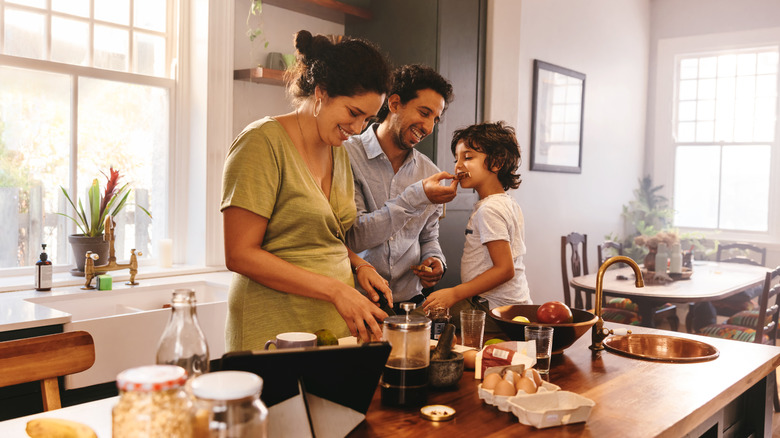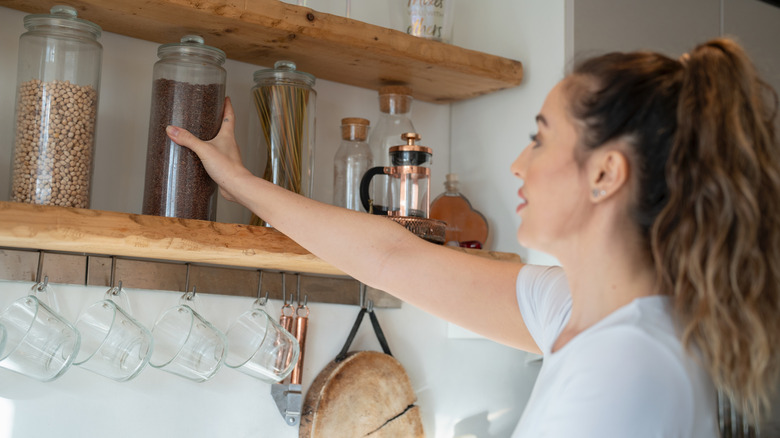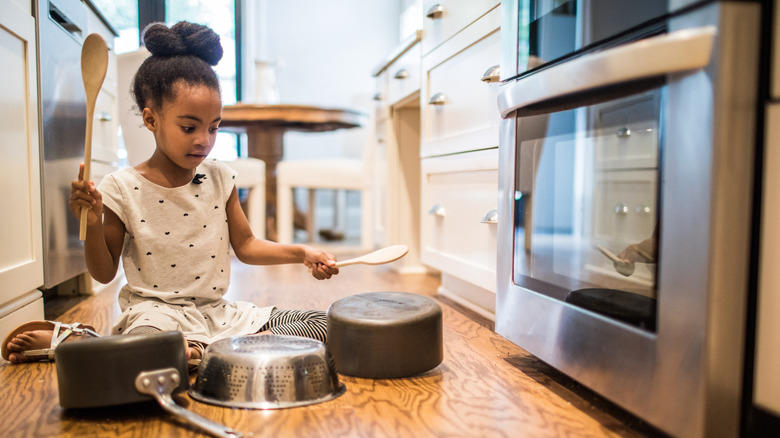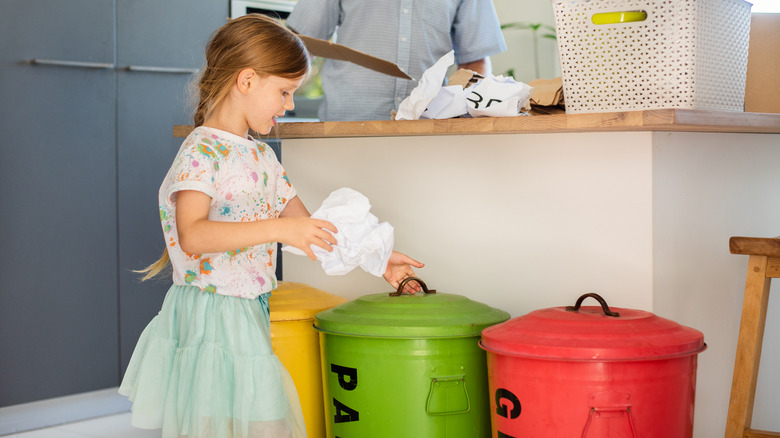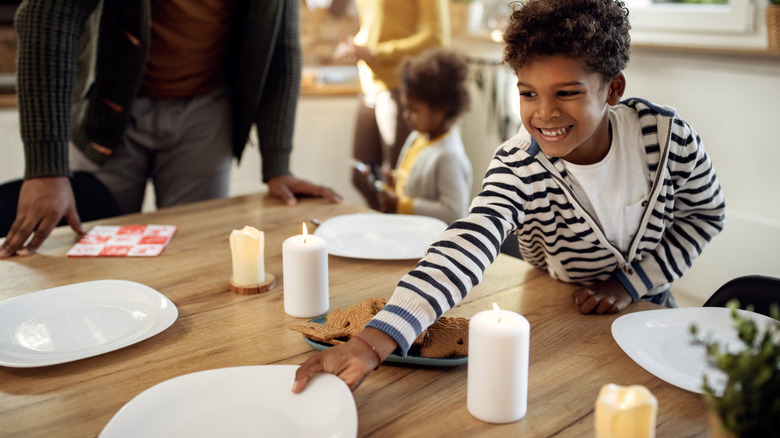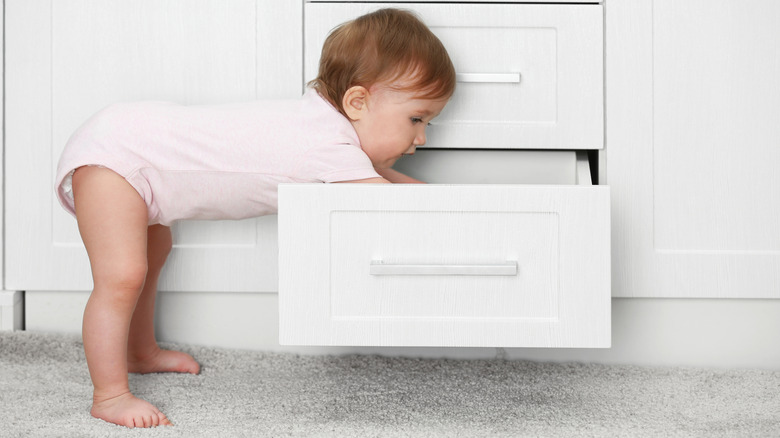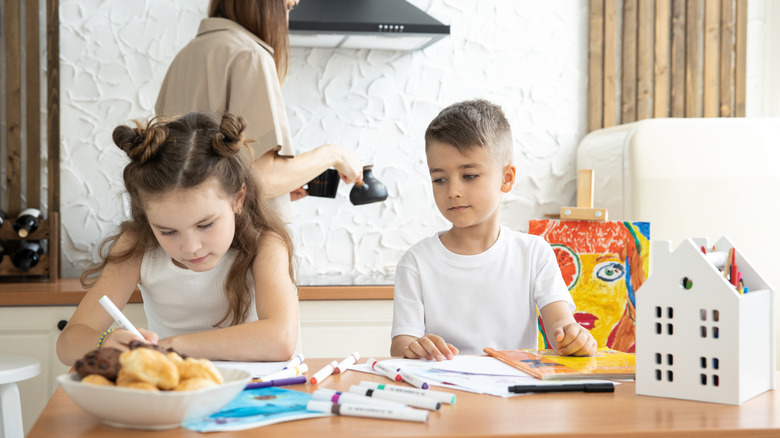6 Ways To Reorganize Your Kitchen To Make It More Kid-Friendly
We may receive a commission on purchases made from links.
The kitchen is the heart of a household. It's where families come together to cook and eat, allowing them to share time and connect. However, not all kitchens are designed to be kid-friendly. If you want those little ones to enjoy the kitchen safely, you'll need to reorganize this space. So, to uncover the best kid-friendly organizational strategies, Daily Meal turned to Maria Baer, Founder of The Baer Minimalist®.
As an organization expert and the mom of six-year-old twins, Baer understands the importance of your kitchen setup. This space sets the tone for the household, encouraging family bonding and budding young chefs. But since kids grow up quickly, making your kitchen kid-friendly isn't a one-off event. Baer points out, "Your kids will grow out of certain items while they grow into new ones."
This means you will probably need to reorganize your pantry every few months. Although it requires some work, the payoff is worth it. As Bear shares, "It is incredible to watch their independence and confidence soar in a space where they have some autonomy."
Baer explains that helping kids evolve from infants to young adults requires setting them up for success — and this includes age-appropriate kitchen organization. You want to keep toddlers safe and entertained when you're busy cooking dinner. Once old enough, you want to create a space where they can practice their own culinary skills. And if you're inspired to make your kitchen more kid-friendly, Baer has just the tips!
Store dangerous items up high or in childproof cabinets
Maria Bear explains that safety is key to making your kitchen kid-friendly. "It is incredibly important to store anything that could be a potential danger high up in a cabinet or pantry." Think glassware, fragile dishes, electronics, or anything sharp. However, this rule doesn't solely apply to kitchenware. Cleaning supplies and foods you don't want kids getting into should be kept out of arm's reach. Of course, a toddler's reach is far shorter than an adult's. You can still keep everything easily accessible by organizing these items at countertop height or higher.
What should you keep in lower cabinets and drawers? Anything you don't mind kids getting into. Durable kitchenware made from kid-safe materials is ideal. However, we would avoid wicker kitchen storage bins at all costs since they can attract insects. If you do store dangerous items in a lower cabinet, use a safety mechanism. Baer recommends these magnetic locks for cabinets and drawers since they're easy to use while protecting kids and animals. Meanwhile, these stove knob covers allow cooks a clear view of the temperature settings while ensuring child safety.
As kids get older, Baer suggests giving them more access. "You can certainly never be too careful, but continue to reassess the level of safety needed as your kids show responsibility in the kitchen. We want our kids to explore the magic of the kitchen — but not the kind of magic that involves discovering knives or taste-testing items underneath the sink."
Think about the lower cabinets and what's in them
When cooking in the kitchen, you want your kids to feel like they're part of the action. If all the cabinets and drawers are locked, they're likely to get bored and frustrated. Maria Baer explains, "Toddlers love to grab their own items, so make it easy for them."
To keep toddlers engaged, she suggests giving them access to some low cabinets and drawers with kid-friendly items. And to prevent the doors or drawers from slamming shut, she uses a soft-close mechanism. You can find several soft-close mechanisms online, including DecoBasic Soft-Close Cabinet Hinges that are easy to install and provide a gentle, slow close. Not only is it safe for the little ones, but you won't have to hear those cabinet doors slamming.
Mind you, whatever is accessible to kids may end up on the floor, which is why Baer encourages using locks for certain cupboards. Anything that can create a giant mess should be kept closed, "or you will constantly find yourself frustrated with the clean-up process at the end of the day."
Is that cabinet full of baking supplies? It'll become a toddler's art project on the floor in no time. To avoid this issue, only keep easy-to-clean items in low, accessible cupboards. This is also a good place to organize empty plastic storage containers.
Organize with lanes, labels, and colors
Reorganizing your kitchen is the perfect opportunity to teach kids organizational skills. Eventually, they'll be arranging their own closets and desks. Since kids learn through example, show them how it's done in the kitchen. For toddlers, Maria Baer says, "Consider adding in drawer dividers to create 'lanes' within a drawer – one for water bottles, one for plates [and] bowls, one for snacks."
Although simple, this teaches children how to categorize objects. If you're unsure where to begin, check out Daily Meal's expert-recommended system for organizing your pantry. It says to treat your pantry like a grocery store, keeping like items together in the most logical area. Just make sure to apply kid-friendly rules throughout the process. Baer adds, "If compelled, you could even add labels, but consider picture labels rather than words if they are not able to read yet."
Or better yet, use both pictures and words. As kids develop reading skills, it will help them associate words with objects. You could also use a color-coded organizational system or a combination of all three methods. All these systems help deepen the children's categorization abilities, and using labels, colors, and images will only help reinforce organization. It can even teach kids how to separate trash and recycle appropriately.
Keep the right items accessible to develop autonomy
The whole point of a kid-friendly kitchen is to make it inviting. Kids want to feel welcomed and helpful, especially as they get older. Maria Baer describes how building children's autonomy means giving them a purpose. "We wanted the kids to feel empowered to help in the kitchen – whether that be setting the table, helping put away leftovers, or grabbing a trash bag to refill the can." Encouraging these behaviors requires the right tools. For Baer, this means keeping "plates and Tupperware in lower drawers and adding a soft close to our trash pull-out (with bags nearby)."
If kids are at the appropriate age, Baer also suggests creating an approved snack drawer. We recommend providing single-serving snacks or dividing them into pre-portioned containers. Filling the drawer with these healthy options helps kids develop good eating habits. It can teach them to listen to their body's hunger cues and act accordingly.
Create a designated toddler cabinet
How do you keep toddlers happily entertained while cooking? A designated toddler cabinet! Maria Baer has personally seen success with this method. "I loved having a cabinet in my kitchen that had a few toys tucked inside, so they were easy to grab out when I was cooking a meal." This allowed her to keep her toddlers nearby yet occupied, which is a blessing for busy parents. Plus, it enables bonding time and helps kids get comfortable in the kitchen from a young age.
So what should you keep in such a cabinet? Child-safe, accessible items that they enjoy playing with. These can be kitchen-related things like plastic dishes and utensils, pretend food, or kid-sized dust pans and sponges so they can participate in "helping." They can also be a collection of your toddler's favorite items, like blocks, shape sorters, or musical toys. Whatever toys you choose, make sure they're easy to wash in case anything spills while cooking or eating.
Create a fun cabinet for older kids
As kids get older, they may not want to play with toys. However, this doesn't mean they have to hide out in their bedrooms. Cooking can become a family affair by encouraging everyone to be in the same room. For older kids, Maria Baer suggests "turning that toy cabinet into an art zone so that your family can all enjoy being near one another when creating." Some may be slicing and dicing veggies while others are drawing masterpieces. As long as everyone is relaxed and enjoying themselves, they're more likely to bond.
Fun cabinets can contain art supplies like markers, coloring books, bead sets, or child-friendly sewing kits. However, there's no need to limit these cabinets to art. If your kids are more into games, stock it with solo and group options, including cards, dice, and board games. It's also a good idea to provide homework materials like paper, pencils, and erasers. Kids can work on homework or school projects while parents cook, making it easy to reach out for help when needed.
